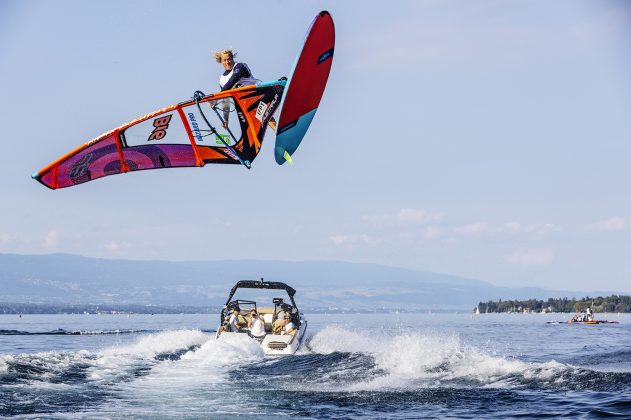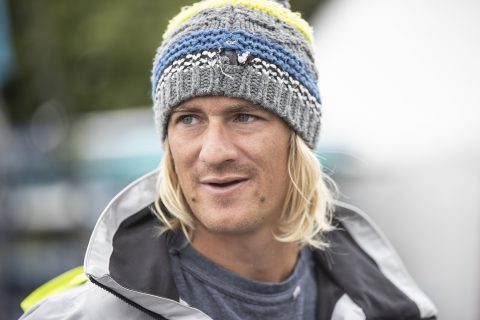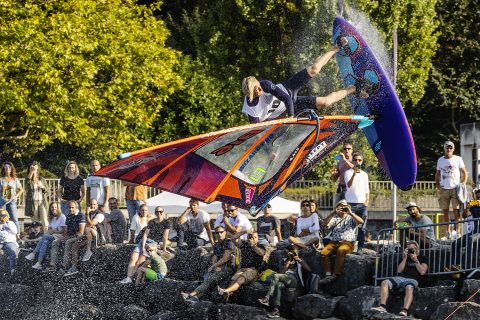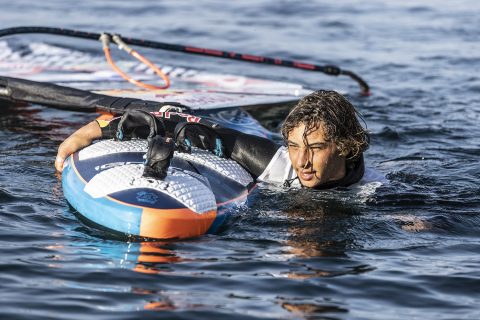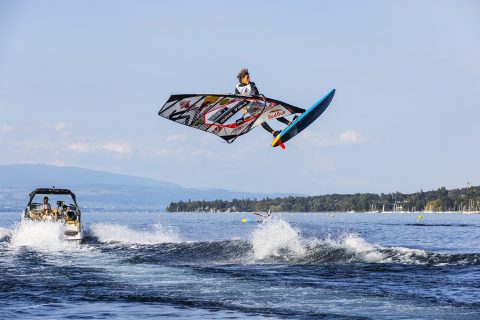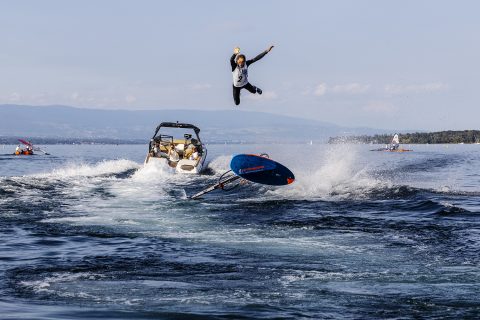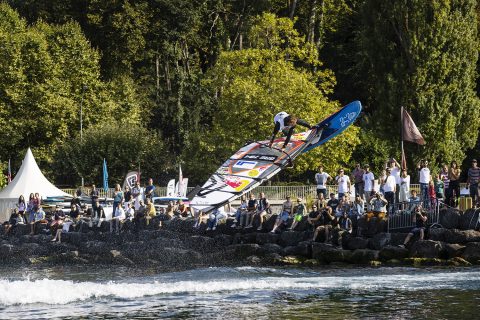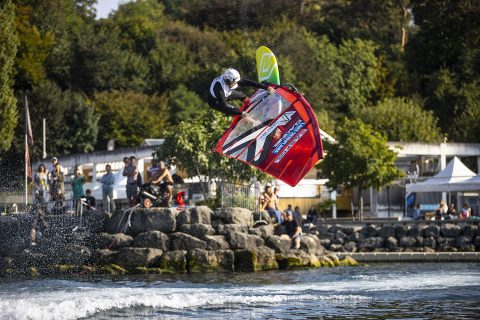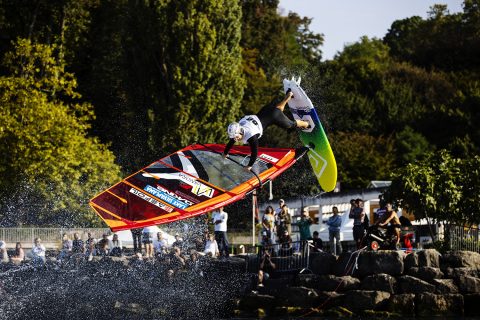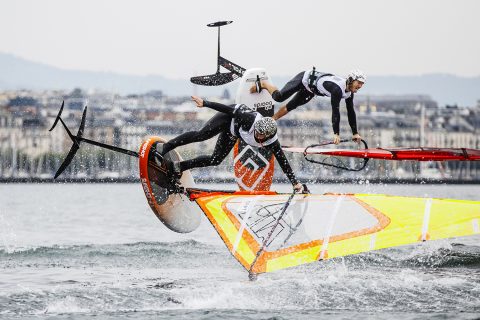TOW-IN WINDSURFING: TOW TALK
Tow-in windsurfing has been the saviour of many windsurfing events over the years, allowing freestylers to strut their stuff when the wind doesn’t play ball. But at the recent European Pro Freestyle Tour event at the ‘Tropical Corner’ watersports centre in Lac Leman, Geneva, tow-in went next level with the use of a proper wakeboard boat to launch the riders to new heights! We caught up with the tow-in ‘Airstyle’ event winner, Yentel Caers, runner-up Lennart Neubauer and swiss legend, Balz Müller to learn more about the bonkers art of ‘towing-in’!
PHOTOS: John Carter/EFPT // WORDS: Balz Müller, Lennart Neubauer, Yentel Caers.
YENTEL CAERS
Tow-in is not the same as normal freestyle, but I do enjoy it. I’m someone who doesn’t like to wait around all day long, so it’s a nice way to get on the water. Also, tow-in makes for an amazing show. The crowd really can see you coming and know perfectly where we will do the moves, so that’s really cool. I love doing tricks close to the crowd. Freestyle is all about the show for me – showing what’s possible and making a good show. With the tow-in we can bring it closer to the people, that’s amazing. I‘m not the biggest fan of the competition part of it, but it really helps us to save an event from nothing happening and delivers good footage and pictures.
- Yentel Caers
TOW LIFE
I always keep my equipment rigged the same as for normal windsurfing. I never change the setup, if the sail feels too big, I just change to the size down. For the tow-in I use my 93-litre board with a 19 cm fin and 4.4. Some guys use the 4.0 to rotate faster, but I prefer more power.
I’m not sure how hard tow-in is, as for me it feels quite easy for the normal moves. Of course, we are pushing for the biggest and hardest moves and then it’s harder. I never train, the only time I do it is in competition. But I have been doing it since it got invented years ago.
The crashes can be hard and painful, but I never got really injured and let’s keep it like this! It’s always a little risk and that’s why some people are not doing it, but I think it’s a risk that’s worth it. I love the feeling and the show.
I use the same technique as normal windsurfing to setup for a move. We can go bigger because we can hit the wave with much more speed than we can in normal freestyle. We also never train for it, if we did train, we could maybe go even bigger, who knows?
- Yentel action
GENEVA
The EFPT Geneva event was great fun. We went there for a foil style event, but unfortunately there was zero wind the whole week. For tow-in it was amazing and perfect conditions. I have been asking for the last few years to bring a wakeboard boat for tow-in and finally the Geneva event stepped up to do it. And I think I can proudly say the results where amazing. This must have been the biggest we ever went for tow-in and also all the riders were going off, so I’m hoping for other events we always have a wakeboard boat as a backup for no wind days. Having a wakeboard boat and a fast winch/jet ski makes it a lot of fun. Also having a little bit of wind helps to control the landing, but not too much, just a few knots max.
LENNART NEUBAUER
I like tow-in quite a lot because I can do it at some pretty sick locations, like the event we just had in Geneva. The fastest I’ve ever been pulled behind a jet ski was 78 km/h, then the adrenaline goes through the roof!
- Lennart chilling
STARTING
Zero wind and completely calm water is best when trying it for the first time as getting up is actually the hardest part. Most people try to pull the rig towards themselves as soon as they start moving, but that’s the biggest mistake you can do because you’re simply going to fall backwards. The key is to very slowly grab the sail by the mast, and as soon as you start picking up some speed, gently move your hand up the mast until you reach the boom. By that time you should have enough speed to get into the straps. It is very important to place your body weight over the back foot so that the nose doesn’t dive. Remember the faster you are, the more stability you feel.
I would say a good driver makes up about 40% of tow-in performance. I always say the best case is if the driver is a windsurfer too, so that he can understand the wind direction and so on. I think as a jet ski or winch operator, the winch is the easier option since you are stationary and can focus 100% on the rider you are towing.
- Lennart wake action
SETTINGS
Some people say to rig the sail a bit flatter than normal, but I prefer to leave the sail on the setting I also use it when it’s windy. I feel like it makes less difference for tow-in if my sail is not rigged perfect, than it does for windy windsurfing conditions.
My feeling is that the best speed is around 65 km/h with a wave and about 70 km/h on flat water. That is because you need max speed for the double or triple pop moves! I can tell you that even the smallest bits of chop can feel like a big swell when going that fast ha ha. For regular moves, the speed should be lower, otherwise it’s too hard to control the move. It is also super important to not wait too long to pop your trick after letting go of the handle, otherwise the speed is gone before you even realise!
In Geneva I felt like the timing was key for a good jump. The thing is that for double or even triple rotations you need to take every bit of speed with you, so I try to let go super late, so that as soon as I let go of the handle and put my hand on the boom I’m almost taking off already. It’s not that easy, but luckily I have never really had an issue with mistiming my jump.
- Superman time!
MOVES
The difficulty of the moves is almost opposite to regular sailing. For example a spock is much harder than a burner. That is because the apparent wind wants to push you downwind like an air funnel or burner, so a spock is hard because it’s against the natural direction of the wind. Skopus are also very hard to land for that same reason. I remember doing my first burner was when I was 12, towing-in in Croatia, it felt great!
Regular moves are very hard for two reasons. One is that your body is twisted in a weird way, which makes it hard to hold the sail in place, and for me I feel like often the sail drops to the water when I’m trying to grab the boom with my front hand. Secondly, as mentioned before, any kind of small chop can make you have the catapult of your life, which can hurt a bit ha-ha. Switch moves are a lot easier because you have the sail in front of you, which makes everything feel a lot more natural.
- Moves for the crowds
I think there is no simple answer for if things are easier or not towing-in with wind. For example a skopu is much easier with a bit of wind than no wind at all (wind meaning about 10 knots), on the other hand a double pop move is easier with no wind, because with wind there comes a bit of chop too, which for combinations is not ideal. It also comes down to personal preferences too; if I had to choose I would say a bit of wind for me please! It just makes everything feel more like windsurfing, so yes I’m a fan of wind when doing tow-in.
I think the new EFPT tow-in competition format (Editor’s note – in the new format the riders have rounds with specific categories like air, combo, regular and ‘send it’) is very nice because it forces us to do different stuff and not always the double air burner, because let’s be honest, if done perfect it comes close to a perfect 10 and it actually isn’t that hard to do, so in the end it would be a double air burner competition!
COMPETITION
Being fully relaxed is the best strategy for myself when competing and this year proved to me that it works very well. Actually, there is not a lot going on in my head before I take off! I tend to look around a bit and when I see that I’m closer to the ramp everything blurs out and I focus 100% on hitting the ramp in the perfect spot.
The fact that we can place a competition in the centre of a city, on top of a mountain or even in a pool is just amazing! Also, the fact that I know exactly when everything is going to start let’s me prepare even better. This is the perfect way to introduce windsurfing to people watching from outside our sport. I personally always feel more like doing a show than a competition as it takes a lot of pressure away and let’s me do my thing out there.
BALZ MÜLLER
I do like the crazy possibilities we get from riding more than double the normal speed with tow-in, but I hate the high injury risk from the unnatural crashes coming along with it. In general, I’m not a big fan of engine-powered sports, especially in windsurfing where we use natural wind power to get creative. The physics are simple, there is so much speed, but no real sail power.
- Balz Muller
GET IN POSITION
At first it feels very weird and you’re asking yourself why you’re not simply getting rid of the rig and going wakeboarding instead. But with the right technique it’s easy and doable for everybody. The most important part is that the clew of the sail is pointing back, your sail is positioned flat behind you on the surface and your back hand is holding the mast, which you can then, with the pulling speed from the rope in your front hand, lift up easily. Personally, I go straight into my straps, but that’s a bit trickier than placing your feet wide on the board and moving into the straps once you picked up speed.
Of course, you are totally dependent on the person in charge of the pulling rope, especially the start and speed control in the first metres is all in the hands of them. Rookies behind the winch can easily destroy a world champion’s run.
- CRazy moves from Balz
PROS AND CONS
We don’t really need the sail for tow-in, so I prefer to ride my small sail with much more outhaul. I think it gives me more control and less drag.
The timing for tow windsurfing is very hard if you want to hit the ramp with full speed, but at least it’s always the same kicker, so you get used to it quickly and can use the ramp much more efficiently than real chop.
Rotations where your body follows the sail into the wind like a flaka, burner or culo can be easier to learn in tow-in without real wind pressure in the sail as is normal in windsurfing. Because of the same effect we’re also able to land multiple air spins easier in tow-in.
- Balz push loop
Switch stance riding is very hard to control in the run-up before the trick, especially in choppy water, but once in the air they feel great. If there’s some wind the tricks feel more natural, but the run-up gets super complicated. Then I’m asking myself why I’m not flying around on my foil instead.
I tried a push loop in Geneva and that felt not so bad. The wave seemed too small, but surprisingly I got plenty of airtime and a fast rotation.
Tow-in crashes feel unnatural and I have fear from all the injuries I have had the past year. My dad has been telling me for years that this discipline has nothing to do with windsurfing. The action is great for spectators, but I think waiting for wind is part of our cool sport. And compared to normal wakeboarding action, it’s hard to compete with our dragging sails and big boards.
FOIL TOW-IN
- Tandem foil tow in
The take-off when tow-in wind-foilstyling feels weird, but once flying it feels great and free just like powder snowboarding. For doing tow-in wind-foilstyle tricks, I miss the power in the sail on landing. That’s a point which lacks in all tow-in windsurfing, that secure feeling on landing I get holding on to the pull of a boom that is driven by a powerful sail.

